Robert Rauschenberg | Celebrating Four Decades of Innovation and Collaboration September 20 - December 19
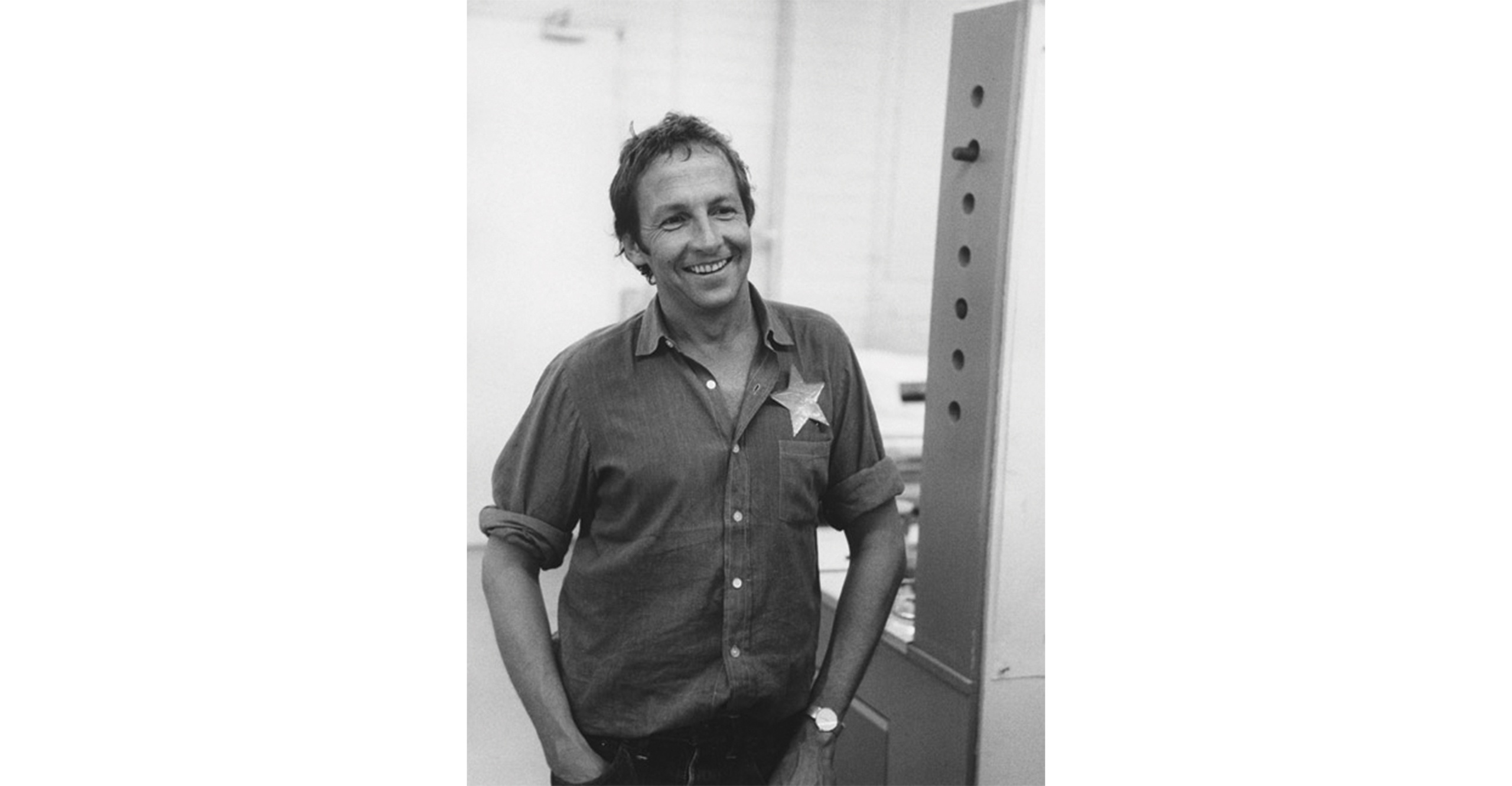
Robert Rauschenberg during the proofing of Stoned Moon series. Photo © 1969 Sidney B. Felsen
The works presented in this celebration feel like a journey—not just through the artist’s four decades at Gemini G.E.L., but through the restless, searching spirit that defined him. From the moment he stepped into Gemini in 1967, Rauschenberg seemed to expand the very idea of what printmaking could hold—folding in the unexpected, the ordinary, the cosmic, and the deeply personal. This exhibition is as much about his vision as it is about the alchemy of collaboration: the way paper, ink, fabric, light, and found matter can become something alive, something that still speaks to us decades later.
The artist’s job is to be a witness to his time in history.
-Robert Rauschenberg
Booster and Seven Studies (1967)
After having met the Gemini partners in the previous year, Robert Rauschenberg arrived at Gemini G.E.L. in February 1967 to begin his first collaboration with the nascent publisher, creating Booster and Seven Studies. He told Gemini’s co-founders, Sidney Felsen and Stanley Grinstein, that he wished to create “a self-portrait of inner man,” which would require an X-ray of his entire body. Doing it in one complete scan wasn’t possible in Los Angeles and would have meant his having to return to the east coast, so he elected to be X-rayed in six sections. Rauschenberg’s body floats over a celestial chart tracking stars and planets, surrounded by magazine clippings and mechanical imagery, including power drills and a rocket launch pad. Throughout his career, Rauschenberg adapted to the constraints of locale, techniques and materials, and Booster, with its partitioned imagery, is the earliest evidence at Gemini of the extraordinary results created by that adaptability. Furthermore, Rauschenberg always pushed the limits of any medium in which he worked, and the scale of Booster – followed by Sky Garden and Waves in 1969 – resulted in perhaps the largest lithographs printed in that era.
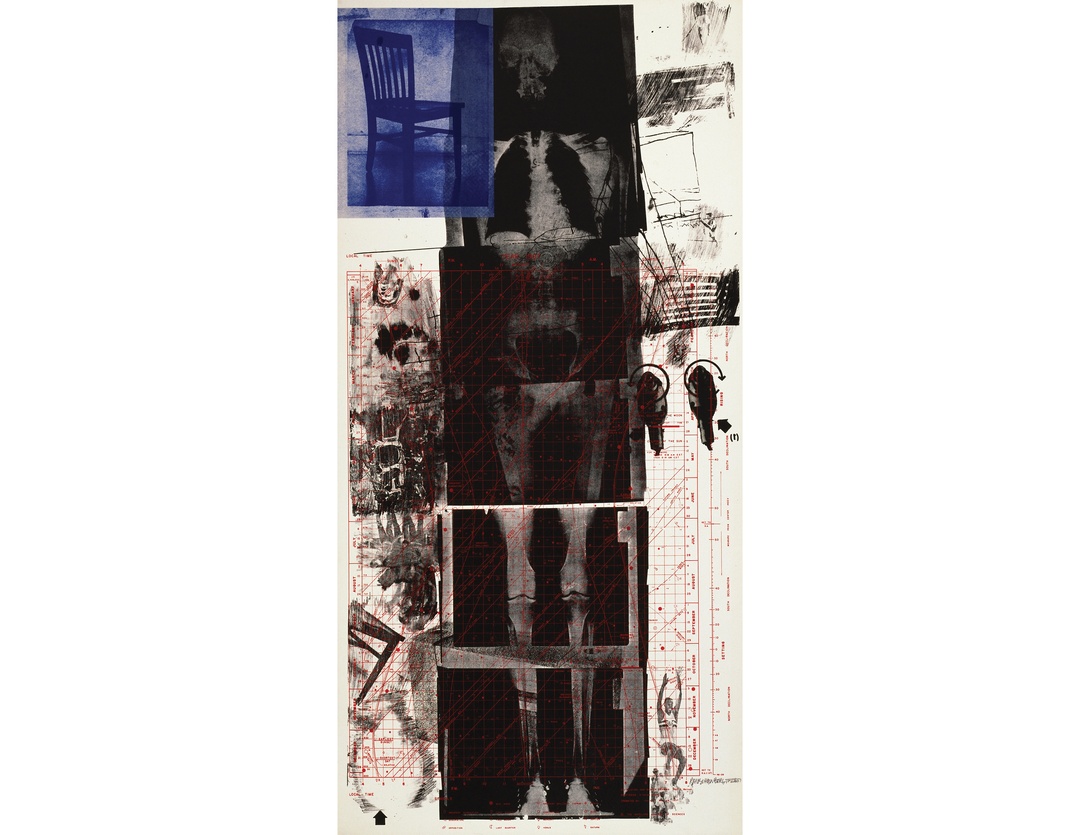
Booster and 7 Studies, Booster, 1967, 5 color lithograph 72 x 35 1/2 in. Edition of 38
Stoned Moon (1969-70)
Inspired by his attendance at the Apollo 11 launch, Rauschenberg’s Stoned Moon series blends the ethereal with the tangible, and Sky Garden is its luminous centerpiece—a burst of color and wonder. This work, as well as the smaller-scale prints, blend NASA photographs with images of the natural environment, birds, and poetic handwritten reflections. Rauschenberg combined Florida’s swampy landscapes, rocket plumes, boot prints and helmet reflections into visual elegies for space exploration.

Stoned Moon Series, Sky Garden, 1969, 6-color lithograph with screenprint, 89 x 42 in. Edition of 35
MY HEAD SAID FOR THE FIRST TIME MOON WAS GOING TO HAVE COMPANY AND KNEW IT.
-Robert Rauschenberg
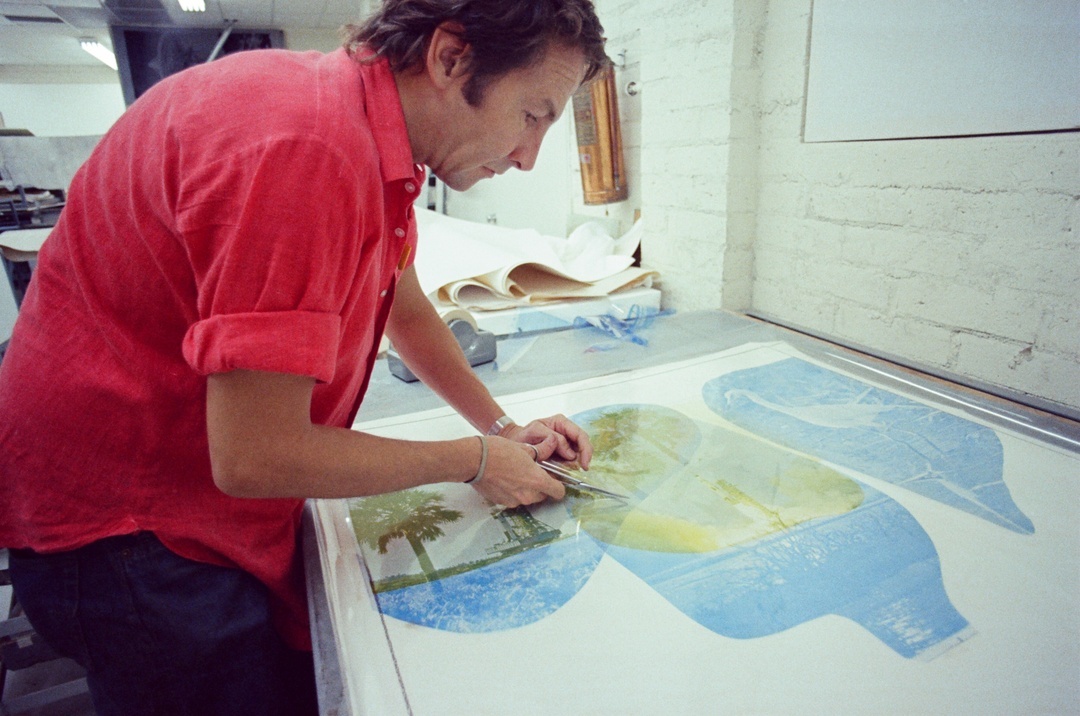
Robert Rauschenberg at Gemini G.E.L., working on Sky Garden (1969)
Rauschenberg was the consummate collaborator, and his infectious smile and his love for people took hold at Gemini. He said “with two people you always have at least three ideas.” The 34 editions in the Stoned Moon Series were proofed over a two-month period in marathon sessions that often occurred round the clock, requiring infinite stamina on the part of both the artist and the printers.
Earth Day (1970)
Rauschenberg’s work has always been deeply connected to the world around him, and Earth Day captures this urgency with striking clarity. The distressed bald eagle, poised amid polluted highways and dying forests, becomes a symbol of the fragile balance between nature and human industry — a call to reflection and responsibility that resonates today as powerfully as it did then.
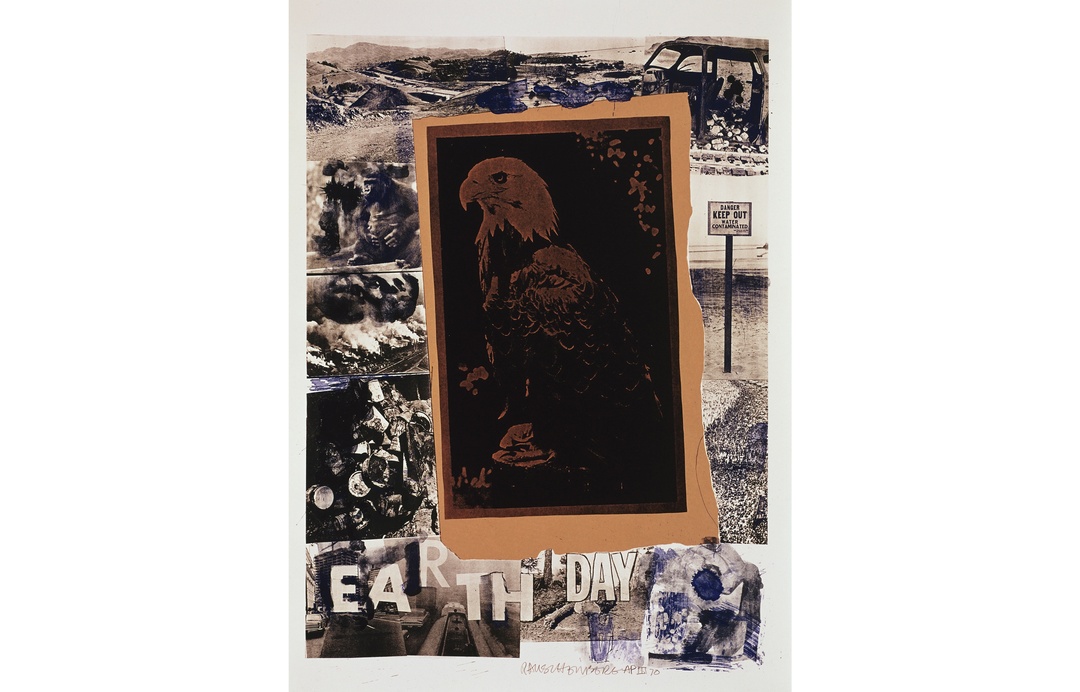
Earth Day, 1970, 7-color lithograph and collage, 52 1/2 x 37 1/2 in. Edition of 50
Cardbird Series (1971)
Rauschenberg didn’t want to use materials, nor did he want to make materials do something he wanted. Instead, he wanted to collaborate with materials, so they could realize their own qualities. From discarded cardboard, both actual and fictional brought to life through the magic of printmaking, Rauschenberg created one of his most poetic series. The Cardbirds – so named for their feather-like delicacy – reclaim a humble, overlooked material and elevate it into intricate, tactile artworks. Cardbirds capture every crease, label, stain, and staple in striking detail, with the end result being cardboard removed from its commercial use and reborn as delicate, poetic objects, celebrating impermanence and transformation.
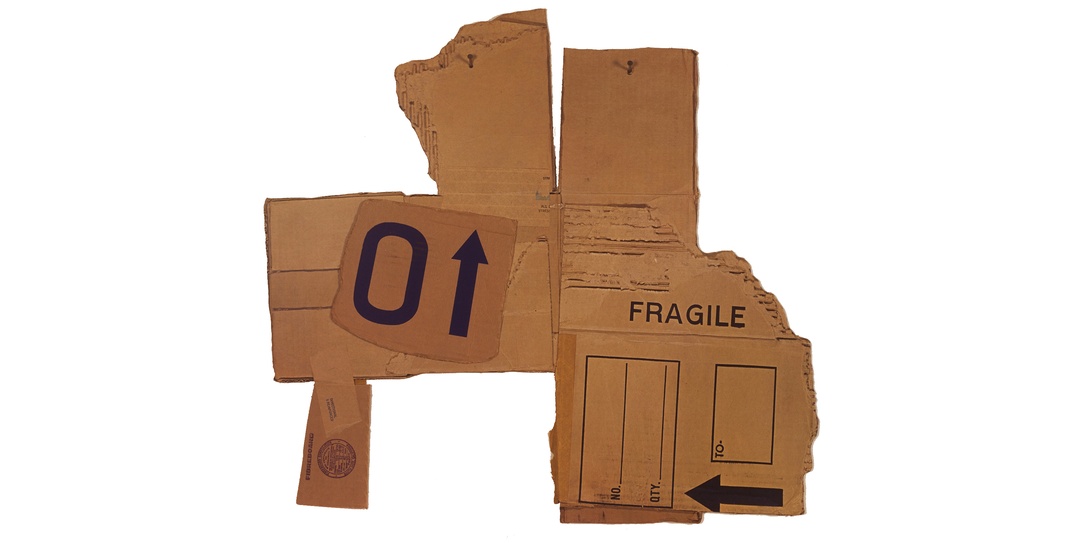
Cardbird Series, Cardbird VI, 1971, Collage print with corrugated cardboard, tape, photo offset lithograph, and screenprint, 26 x 28 in. Edition of 75
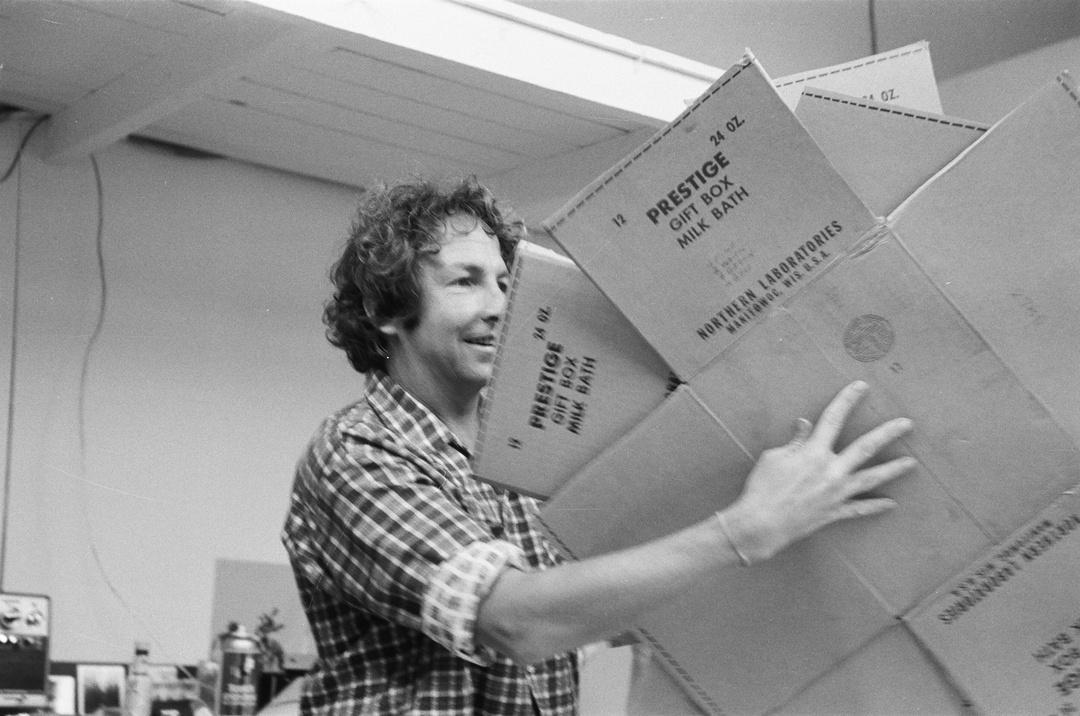
Robert Rauschenberg shaping and bending Cardbird VII, 1971 Photo © 1971 Sidney B. Felsen
Pages and Fuses (1973–74)
Created at a centuries-old paper mill in Ambert, France, Rauschenberg’s Pages and Fuses are the first of several projects that took him and the Gemini staff around the world. The Pages are nearly monochromatic sheets of handmade paper like quiet and austere ritual objects, while the Fuses layer delicate photographic imagery and colored pulp into textured forms. Both are delicate, small in scale and unusually intimate, and together they reveal Rauschenberg’s mastery of subtlety and material poetry. Like so many of Rauschenberg’s aesthetic breakthroughs, this series is often credited with stimulating a new interest left to be explored by other artists – specifically in this instance, where paper is an artwork rather than one on which art is made.
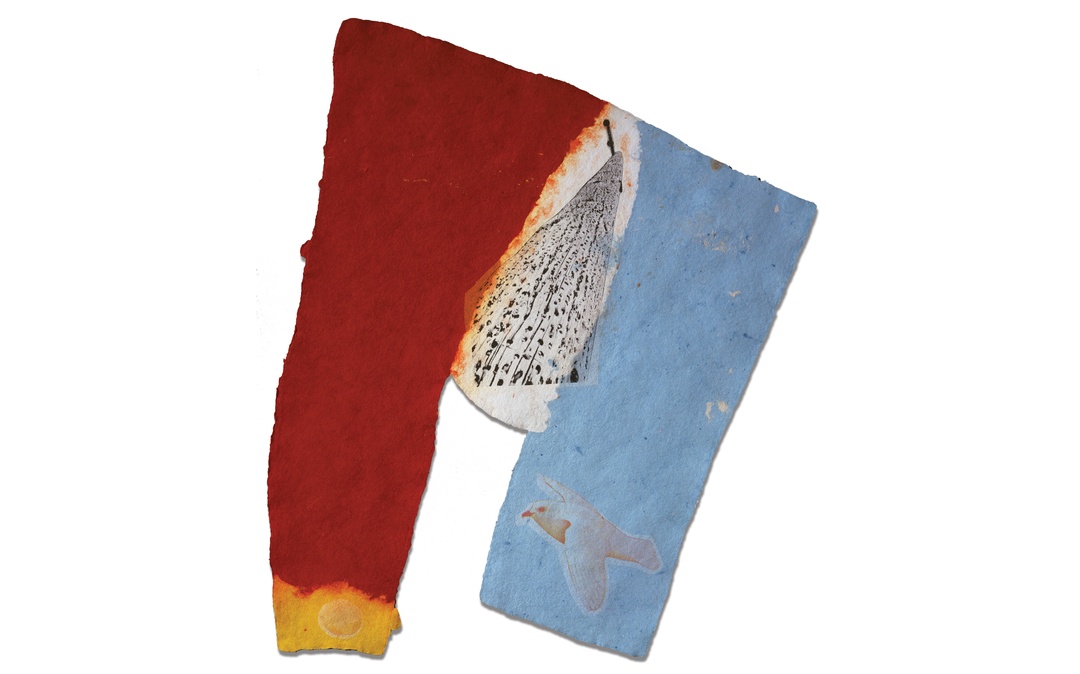
Pages and Fuses, Link, 1974, Handmade paper, pigment, and screenprinted tissue laminated to paper pulp, 25 x 20 in. Edition of 29
As soon as I get too familiar with what I’m doing, then I stop and do something else.
-Robert Rauschenberg
Hoarfrost (1974)
The Hoarfrost series features offset-printed images that are solvent-transferred onto chiffon and satin. These delicate works include illustrations from newspapers and magazines, blurred into photomontages. The works hang from the wall by their top corners, and slight movements in the air, even the breeze of someone walking past, can make a Hoarfrost shimmer. The textile prints float like vaporous poems, capturing the frost of frozen moments. Diaphanous fabrics and offset imagery intertwine, their fragile elegance reminiscent of the flowing robes of ancient statuary.
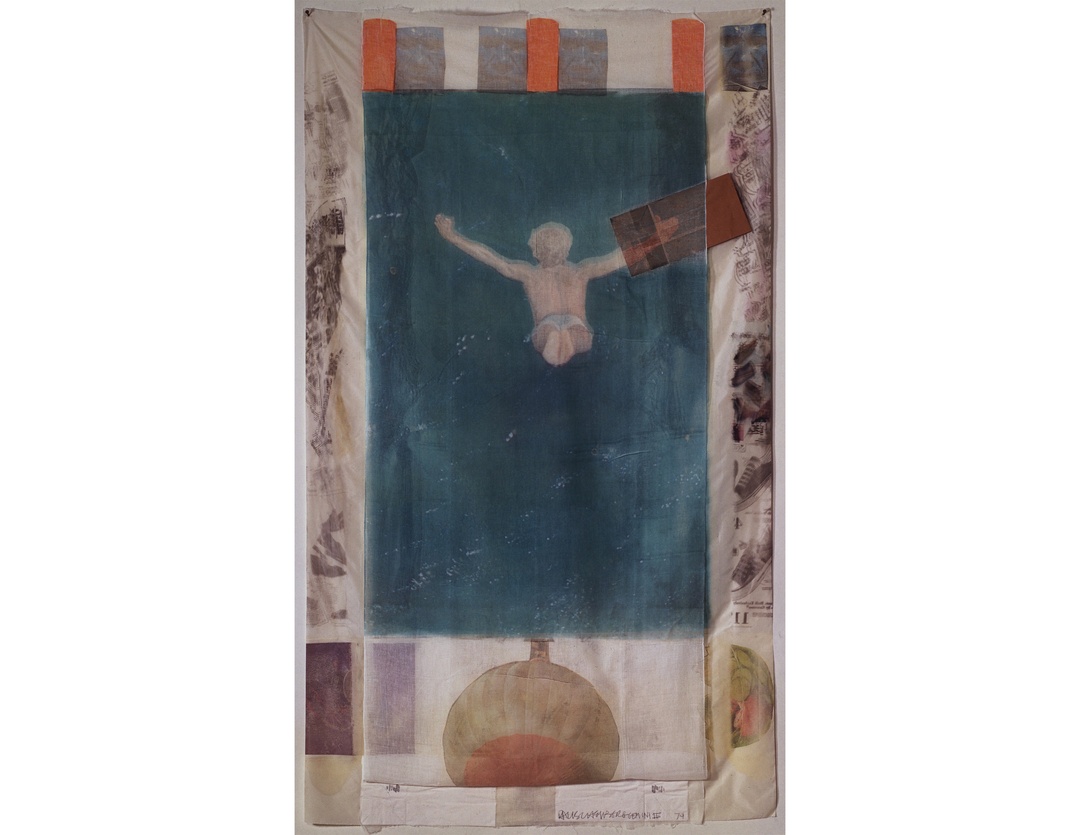
Hoarfrost Editions, Pull, 1974, Offset lithograph and screenprint transferred to collage of paper bags and fabric, 85 x 48 in. Edition of 29
Bones and Unions (1975)
For his second project outside the Gemini workshop, Rauschenberg and members of the Felsen family and Gemini staff traveled to the Gandhi Ashram in Ahmedabad, India. For Bones, patterned fabrics, acquired from a nearby calico mill, and a framework of bamboo strips, made by a local carpenter, were laid into wooden molds filled with paper pulp, and a second layer of paper pulp was then poured over, pressed and dried. The five Bones have a resemblance to kites and explore themes of structural fragility. The six Unions are made of rag-mud, a mixture of paper pulp, fenugreek powder, ground tamarind seed, calk powder, gum powder, copper sulphate, and water. The rag-mud’s strong aroma lasts long after the material has dried and is a distinctive feature of this series. Connected to the hand-shaped rag-mud forms are ropes, dyed strings and bamboo. Rauschenberg’s experience in India, and in particular the introduction of the colorful silk element in Capitol, sparked further exploration and led to his groundbreaking series of unique works, Jammers (1975-76).
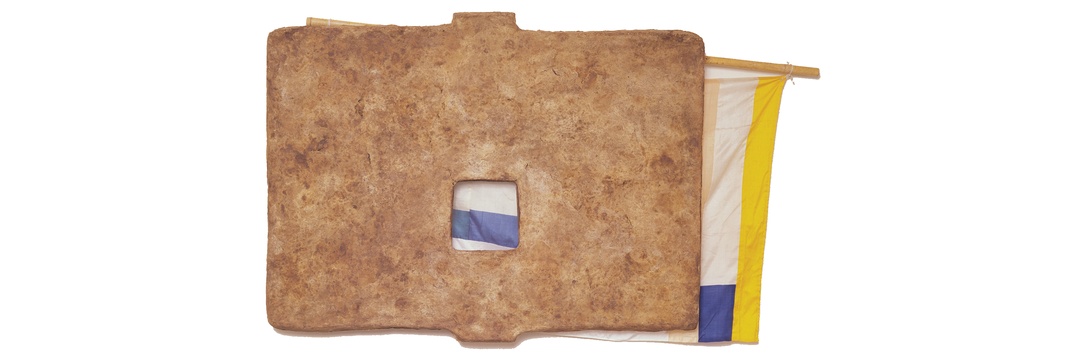
Bones and Unions, Capitol, 1975, Rag-mud, bamboo, silk, string, glass, and teakwood, 34 x 53 1/2 x 4 in. Edition of 10
PUBLICONS (1978)
PUBLICONS marks a major shift in Rauschenberg’s work—from his long-standing use of images to works which have no images whatsoever. This sculptural series of six wall-hanging lacquered wooden boxes unfolds like a ritual: closed, they are minimal and pristine; opened, they reveal a spectacle of color and light, created by strips of fabric and found objects. Their gleaming surfaces and mirrors channel the vibrant spectacle of the late 1970s disco era. Of all the works in this series, PUBLICON-STATION I is the most like an altarpiece, in its shape and the revelation of its central icon, the hand-gilded, electrified paddle.
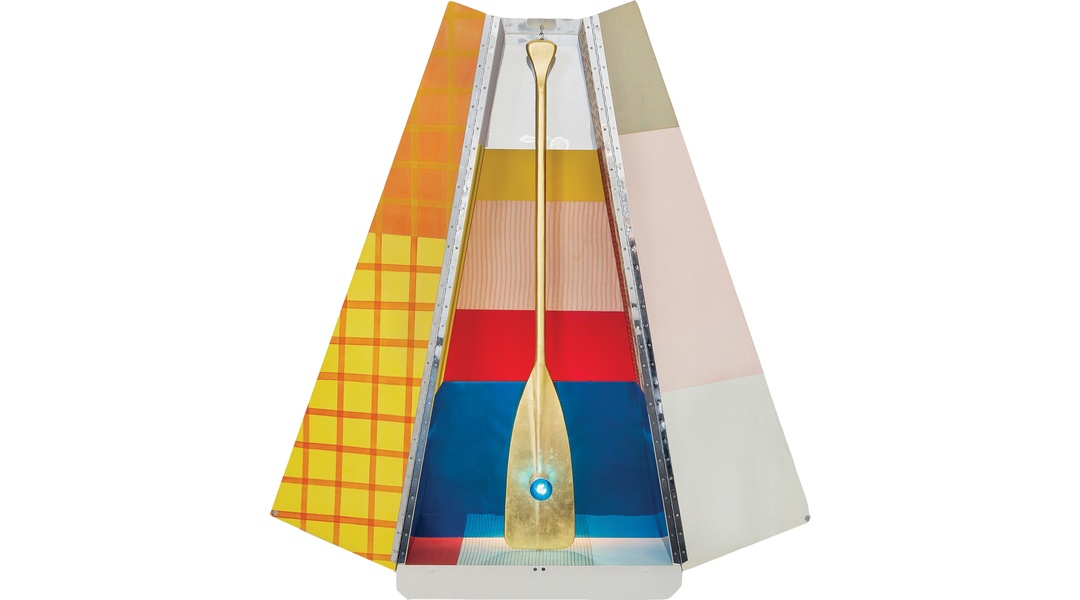
PUBLICONS, PUBLICON--STATION I, 1978, Edition sculpture constructed of wood coated with nitrocellulose lacquer, collaged silk and cotton fabrics, gold-leafed paddle, and baked epoxy enamel over polished aluminum, with light bulbs and Plexiglas, 59 x 58 x 12 in. Edition of 30
Rookery Mounds (1979)
Rookery Mounds, the historic series of eleven lithographs, marks the first printmaking project in which Rauschenberg utilized his own photographs, with the environs of his Captiva Island residence as their inspiration. Rauschenberg had taken beautiful black-and-white photos beginning in the late 1940s, but by around the early 1960s he had, for the most part, set aside his camera. Rookery Mounds became one platform to announce his return to the camera. Much of the photographic imagery which appears in Rookery Mounds looms large on the page, and, compared to prior works, is relatively unlayered. Rauschenberg is making a statement: this is not found imagery plucked from the public domain, these are my photographs. Wheels, tires, fabrics, water, plants and other familiar Rauschenberg visual elements make their appearance in these prints. The eleven lithographs in the Rookery Mounds series are all printed on exquisite sheets of deckled-edged paper, specially made for the project by Twinrocker. This collaboration clearly impacted Rauschenberg’s use of the edges of the paper; a key element of Rookery Mounds is that the imagery embraces and thereby focuses the viewer’s attention to the Twinrocker paper’s stunning deckles.
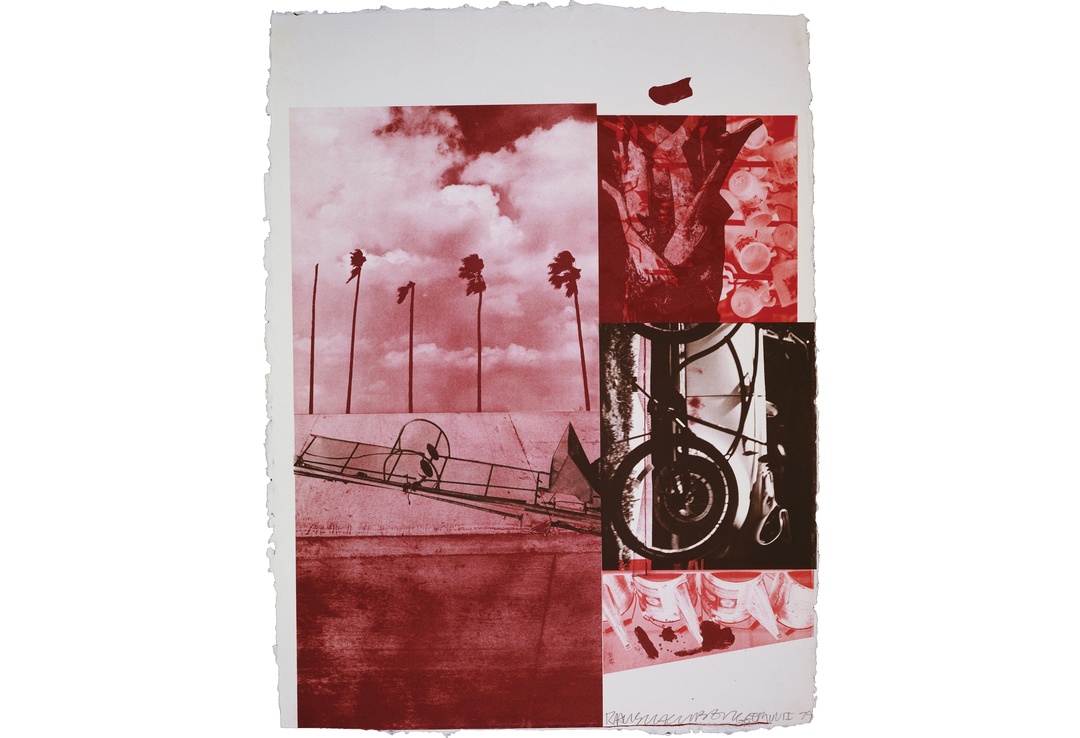
Rookery Mounds, Rookery Mounds--Grape Levee, 1979, 3-color lithograph, 41 x 31 in. Edition of 52
I became addicted to photography again…The camera heightened my desire to look.
-Robert Rauschenberg
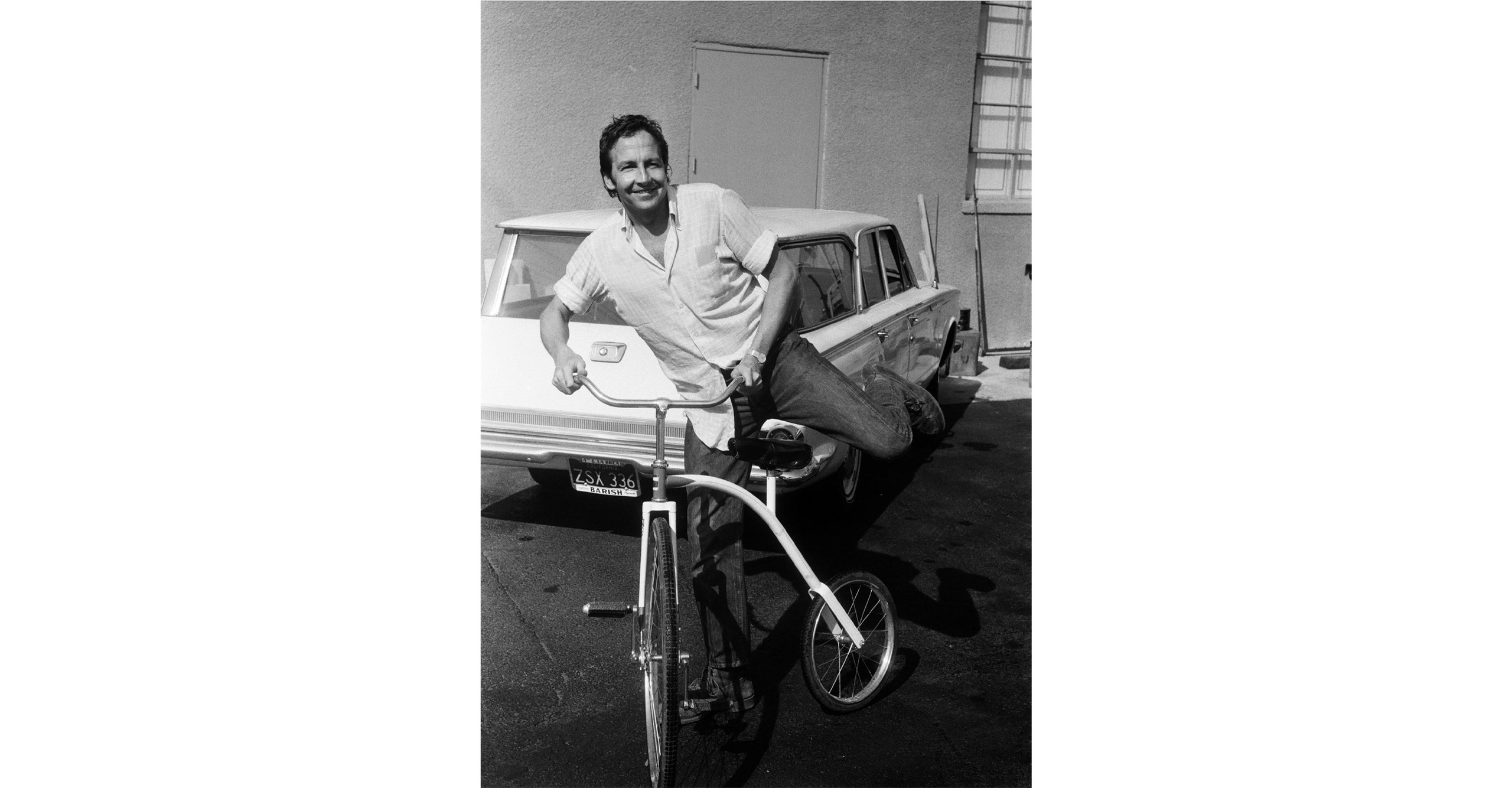
Robert Rauschenberg in the Gemini G.E.L. parking lot after an all-night proofing session. Photo © 1969 Sidney B. Felsen
7 Characters (1982)
In China, working with handmade Xuan paper and silk, Rauschenberg created the 7 Character series. Rauschenberg arranged cut posters, fabrics, and ribbons into unique collages, each featuring one of seven Chinese characters—chosen for meaning and form—mounted in relief. The compositions combine local charts, mask-like silhouettes, bold lines, and washes of color, balancing abstraction and symbolism. A thin Xuan paper sheet sealed the surface, while a medallion, cut from silk wedding bed covers, is suspended at the bottom by a colorful ribbon. The medallion’s reverse is reflected in a mirror on a silk-lined backing within a clear acrylic box frame. The collage edges are gilded with gold leaf, and traditional Chinese woodblock stamps mark the paper mill, artist, and publisher. Rauschenberg’s time in China and a conversation with a local cook, in fact, sparked what would become ROCI (Rauschenberg Overseas Cultural Interchange), a self-funded nine-year travelogue that featured eleven countries and hundreds of artworks. Sharing art and information across borders, enlivening curiosity, and, Rauschenberg hoped, maybe even promoting worldwide peace, by fostering a dialogue with other nations through the language of art.
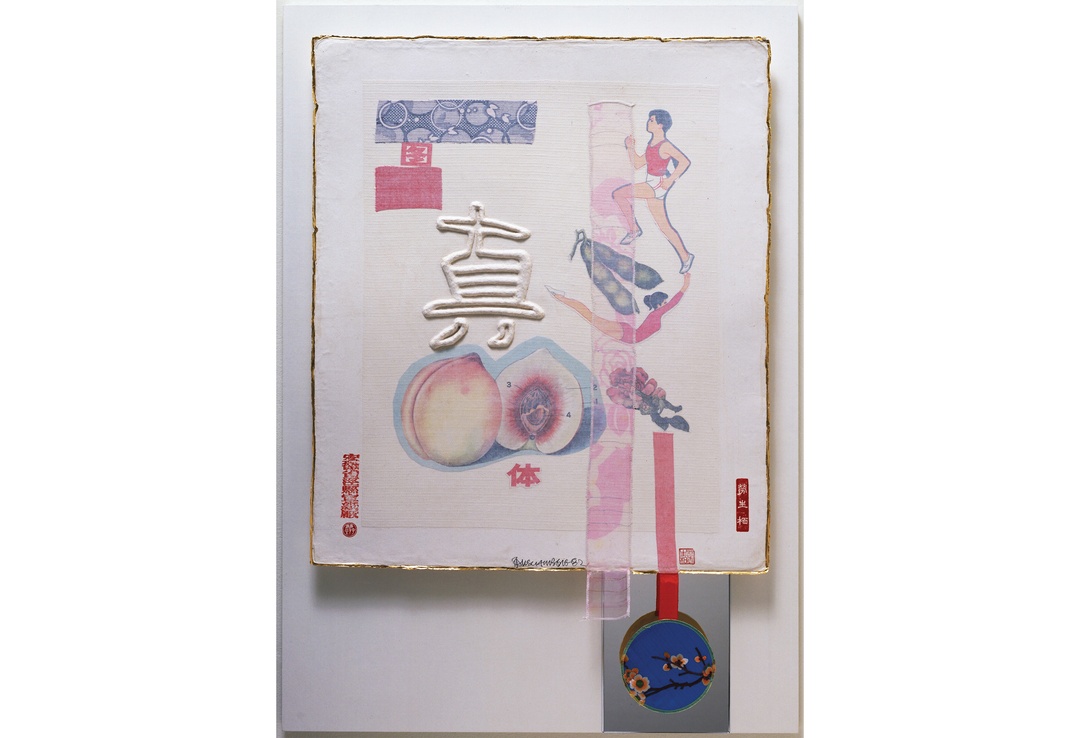
"7 Characters," Truth, 1982, Unique paper and fabric collage, 30 1/2 x 26 1/2 in. Series of 70 unique works
That guy in Italy already did the ceilings, we’ve done the doors [Cardbird Door], so we should do the windows.
-Robert Rauschenberg
Sling-Shots Lit (1984)
Sling-Shots Lit is a series of eleven works, and one of the most technically challenging of Rauschenberg’s collaborations with Gemini. Monumental in scale, they combine traditional printmaking media, like lithography and screenprinting on Mylar and sailcloth, with materials as diverse as a fluorescent light fixture and a movable window shade system. Each Sling-Shots Lit is filled with an energetic combination of Rauschenberg’s photographs. Evoking nocturnal energy—flaring neon, fragmented motion, and kinetic leaps—they resemble visual fireworks, celebrating urban exuberance. Like the PUBLICONS, the Sling-Shot Lit series is interactive; the window shades are meant to be pulled up and down, resulting in an unlimited number of possible configurations.

Sling-Shots Lit, Sling-Shots Lit #5, 1985, 11-color lithograph and assemblage with a sailcloth, Mylar, a wooden lightbox, a fluorescent light fixture, aluminum, a moveable window shade system, and Plexiglas bars, 84 1/2 x 56 1/4 x 12 1/2 in. Edition of 25
Tibetan Keys and Locks (1986)
Inspired by his travels to Tibet, Tibetan Keys and Locks are fabricated from welded steel. Photographs taken by the artist during his trip to Tibet were collaged and screenprinted onto adhesive-coated decal paper. The decals were applied to the surfaces, leaving open one area for hand-painting. Each work was signed by the artist in both English and Tibetan. The vivid, luminous images create a deliberate contrast with the austere simplicity of the geometric, white steel structures supporting them. Each piece layers silhouettes of locks, openings, Buddhist iconography, and abstracted architectural forms. Quiet and contemplative, they resonate like visual mantras.
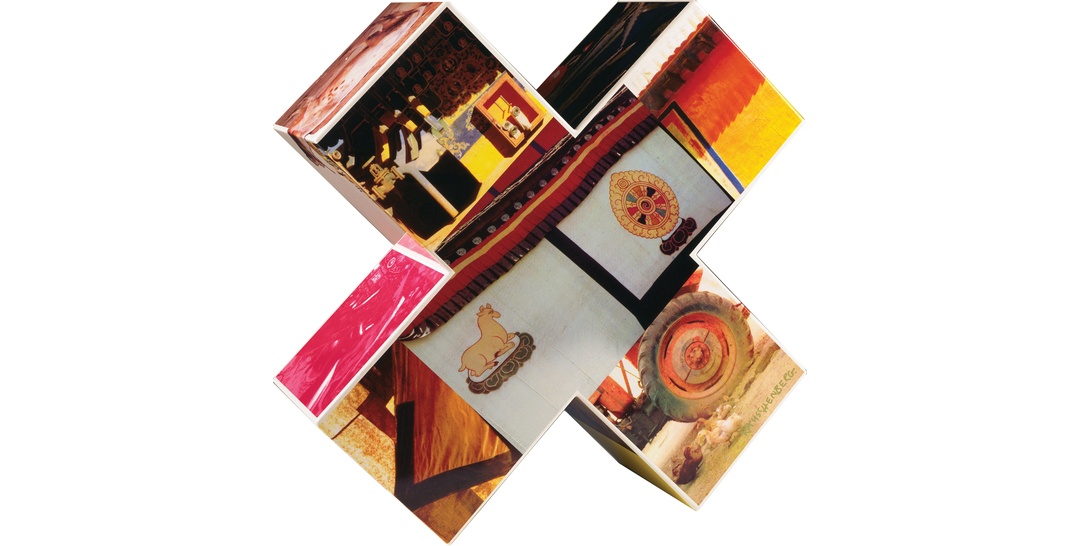
Tibetan Keys and Locks, Tibetan Keys (Centers), 1987, Edition sculpture with decals in photoscreeprint, hand-painted screenprint ink, steel, powder-coating, and polyurethane, 10 x 30 x 30 in. Edition of 18
Robert Rauschenberg first saw the Northern Lights in 1989 on a flight to Sweden. That vast swath of colors flowing across the night sky inspired the title of his 1989-92 paintings on brass, copper and bronze, the Borealis Series. Gemini’s Borealis Shares are Rauschenberg's direct invitation to the viewer to participate in art, a vision he held throughout his career. The two Shares are comprised of 75” x 40" brass panels, each hand painted by Rauschenberg with acid patinas; interestingly, the abstract painting was applied prior to the screenprinted photo imagery, giving the artist tremendous freedom in his application of color without the influence of pre-existing imagery. The brass panels were separated into 4 groups for screenprinting; four different "collages" of photographs taken by Rauschenberg were screened onto the panels, and two groups of panels (for a front and back) were combined to create the two different series of chairs. Despite the utilitarian purpose of the object, Rauschenberg did not want Borealis Shares to simply be pieces of furniture, and he made sure the images on the back shared the same excitement as the ones on the front.
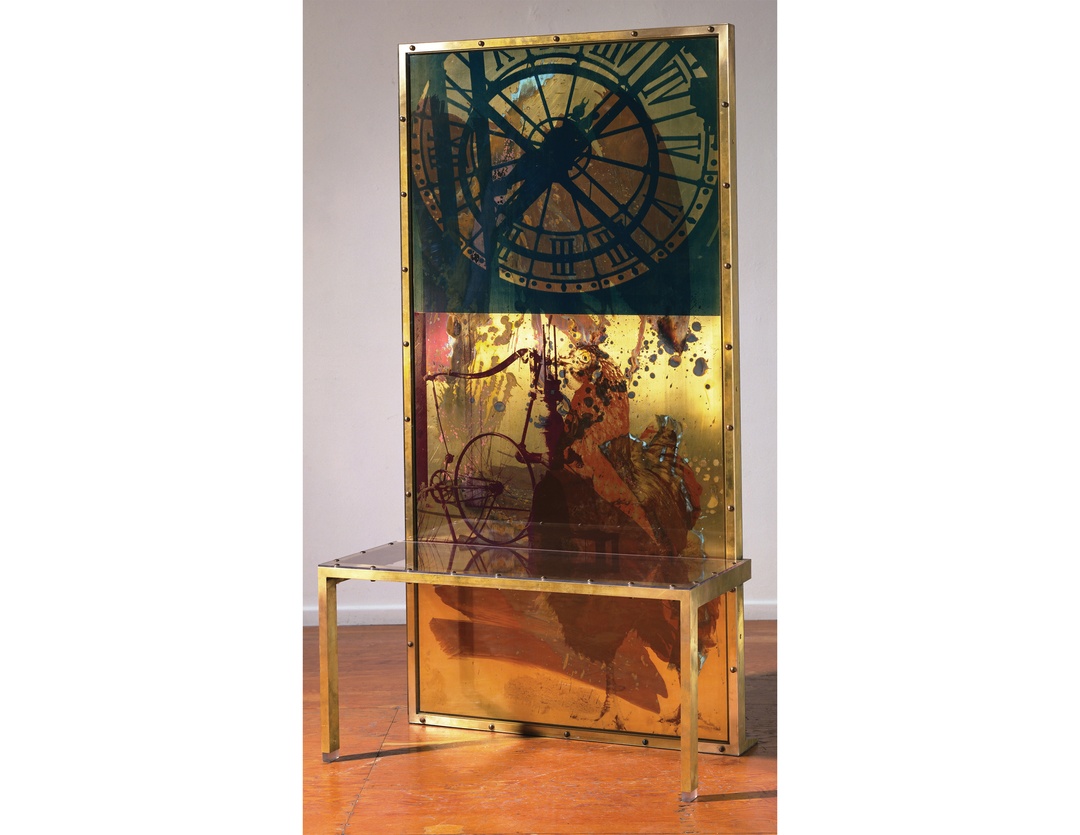
Borealis Shares, Borealis Shares I, 1990, Screenprinted brass and Lexan edition sculpture with patina hand-painted by the artist, 75 x 40 3/4 x 23 in. Edition of 26 unique works
Borealis Shares are titled that way because these objects always look more beautiful when there are two people on them instead of just one.
-Robert Rauschenberg
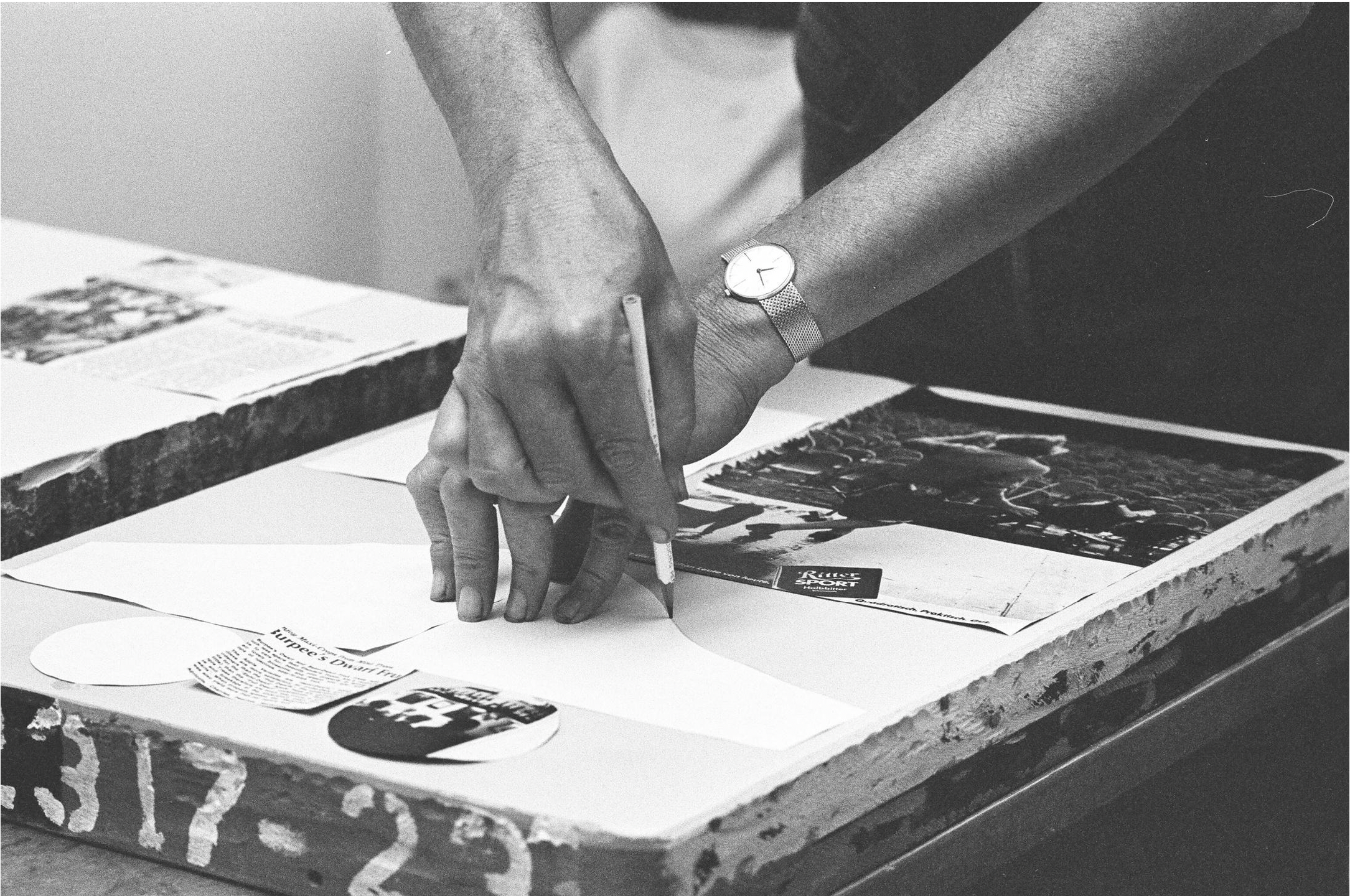
Robert Rauschenberg at Gemini G.E.L., working on a limestone. Photo © 1977 Sidney B. Felsen
This exhibition is part of a global Centennial initiative organized by the Robert Rauschenberg Foundation, activating his legacy through cross-disciplinary events, institutional partnerships, and public engagement.
